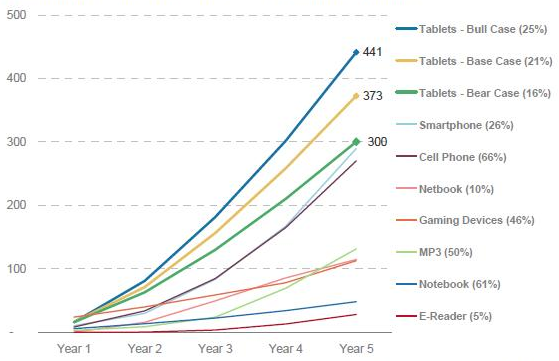There are gender wars, and then there are casualties. It wasn’t until 2011 that the behemoth toymaker LEGO acknowledged girls’ desire to build with bricks, even though the company had long before made a seemingly effortless pivot to co-branding, video games, and major motion pictures. So it’s little wonder that girls face all-too-real obstacles when […]
Read moreTablets are hot, and here to stay, says a new 100-page report from financial firm, Morgan Stanley, which predicts the tablet market will be huge, shipping more than 100 million units by 2012. The growth rate is higher than any other mobile device in history, and will reshape learning. The following charts the total cumulative shipments* in the first 5 years of other mobile devices, and projected growth of the tablet. In millions:

“Bull,” “Base,” and “Bear” represent different possible rates of growth. Even conservative estimates (“Bear”) are explosive. This is relevant for education because it means that tablets are here to stay. Lightweight tablets, controlled by fingertips, are how visitors and students want to consume and access information.
According to Fraser Speirs, Head of Computing and IT at the Cedars School of Excellence in Greenock, Scotland, whose school recently bought 115 iPads so that each pupil has their own dedicated machine for their exclusive use, “The tablet is both information access and creativity in one — don’t let anyone tell you different.” Their school is using tablets in many ways, but portability is important in integrating online information, Mr. Speirs says, even “…if the iPad could only surf the web, we would still have deployed it.”
In the following photo, a girl in Mr. Speirs class is drawing, using as a source both a real life object, and a photo she located online:

Mr. Speirs will be presenting his observations on the iPad later this week, at the “Macworld Mobile iOS Developer Conference” in Barcelona, Spain, and he also discusses these topics on his blog.
Larry Johnson, CEO of The New Media Consortium who recently published a reporton trends in higher education (see our blog post, “Mobile and eBooks big deal for higher ed in 2011“), said that technologies like mobiles are “indeed mainstream — in the world as a whole — but they are far from mainstream in education. Mobiles, for example, are banned from virtually every high school, and most university classes do not yet take advantage of their capability.” That’s going to change rapidly.
The authors of the Morgan Stanley report say:
Fundamentally, tablet computing represents the natural evolution of computing from a graphical, keyboard, and mouse user interface to a touch user interface. A tablet is ultra-mobile and “always connected,” and the significant amount of applications and content designed for these devices increases functionality well beyond netbooks and traditional PCs. As a result, we expect the tablet adoption curve to ramp faster than any other mobile device in history.
Tablets are not on the fringe; they are not just for commuters nor geeks. As Barron’s reports:
[The Morgan Stanley team] did multiple surveys that they say canvased 8,000 consumers and 50 corporate CIOs. The findings show, they write, that tablets are set to be taken up by two thirds of corporations in 2011, either through direct purchase or allowing employees to take up the machines personally within the firewall. And the writers were “surprised,” they note, by what the data said about International demand: “While consensus views the tablet market as largely a U.S. consumer phenomenon, the international consumer survey data surprised us.” Demand in major developed economies, phrased in the survey as “extreme interest in purchasing a tablet in the next 12 months, was higher than in the U.S., with only 11% of U.S. respondents surveyed saying yes, but 15% in France, 16% in Japan, 18% in Germany, 20% in the U.K., and a whopping 41% in China. And the overall international demand was 21%.
* Note on the graph. The graph comes from Morgan Stanley. Percentages represent current penetration rates for each device. Figures for bull, base, and bear case forecasts represent penetration rate in year five. For notebook, cell phones, and gaming devices, shipments are in early years of product history. Source: Morgan Stanley Research, Gartner, IDC, company reports.


15 Feb 2011, 5:29 pm
[…] This post was mentioned on Twitter by Fraser Speirs, IDEA.org. IDEA.org said: 100m tablets in a year. What will that mean for learning? Stats in http://t.co/Tawj0tD and comment from @fraserspeirs […]